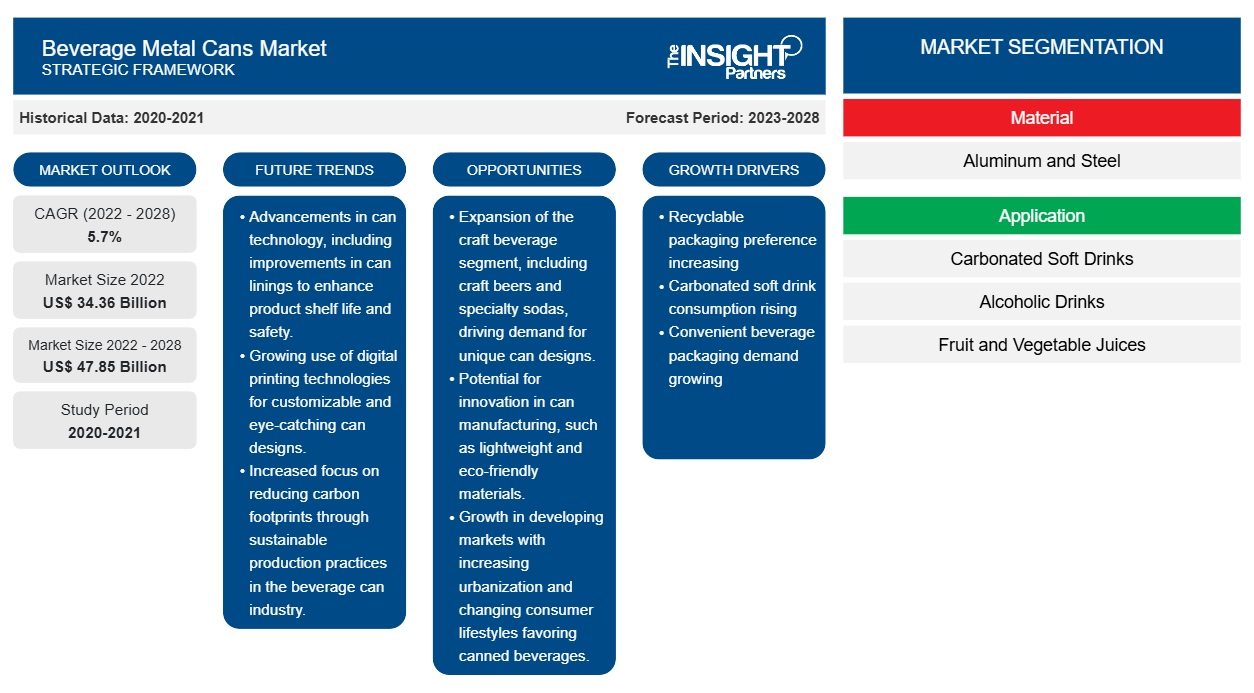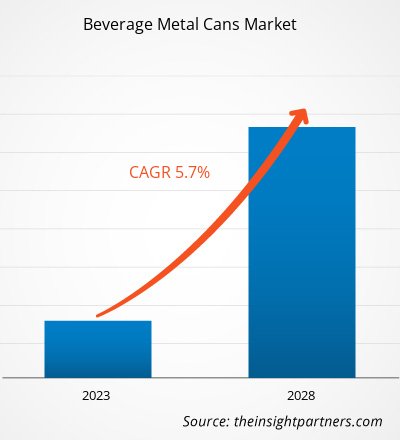Der Markt für Getränkedosen aus Metall soll bis 2028 auf 47.852,42 Millionen US-Dollar anwachsen, von 34.363,14 Millionen US-Dollar im Jahr 2022; für den Zeitraum 2022–2028 wird ein jährliches Wachstum von 5,7 % erwartet.
Das Wachstum des Marktes ist auf das weltweit stark wachsende Umweltbewusstsein zurückzuführen. Daher wurden verschiedene staatliche Vorschriften erlassen, um Kunststoffverpackungen durch recycelbare und umweltfreundliche Metall- oder Glasverpackungen zu ersetzen. Der gesamte CO2-Fußabdruck von Getränkedosen aus Metall ist geringer als der von Kunststoffverpackungen, da der Rohstoff aus recycelten Materialien gewonnen werden kann und im Gegensatz zu Kunststoff keine neuen Rohstoffe benötigt werden. Darüber hinaus sind Metallverpackungen langlebig und gelten als sicher für Anwendungen in der Lebensmittel- und Getränkeindustrie.
Im Jahr 2021 hatte Nordamerika den größten Anteil am globalen Markt für Getränkedosen aus Metall . Der asiatisch-pazifische Raum wird im Prognosezeitraum jedoch voraussichtlich die höchste durchschnittliche jährliche Wachstumsrate (CAGR) auf dem Markt verzeichnen. Der Markt im asiatisch-pazifischen Raum ist in China, Indien, Japan, Südkorea und Australien segmentiert. Länder wie Südkorea, China und Japan gehören zu den wichtigsten Märkten für Lebensmittel und Getränke. Die Region ist auch die Heimat zahlreicher Lebensmittel- und Getränkehersteller, die aufgrund der gestiegenen Inlandsnachfrage nach abgepackten Getränken wachsen. Die steigende Getränkeproduktion im asiatisch-pazifischen Raum und die zunehmende Präferenz für recycelbare Verpackungsmaterialien werden im Prognosezeitraum zum Marktwachstum in der Region beitragen.
Sie erhalten kostenlos Anpassungen an jedem Bericht, einschließlich Teilen dieses Berichts oder einer Analyse auf Länderebene, eines Excel-Datenpakets sowie tolle Angebote und Rabatte für Start-ups und Universitäten.
Markt für Getränkedosen aus Metall: Strategische Einblicke

-
Holen Sie sich die wichtigsten Markttrends aus diesem Bericht.Dieses KOSTENLOSE Beispiel umfasst Datenanalysen, die von Markttrends bis hin zu Schätzungen und Prognosen reichen.
Auswirkungen der COVID-19-Pandemie auf den Markt für Getränkedosen aus Metall
Die COVID-19-Pandemie beeinträchtigte die Betriebseffizienz des verarbeitenden Gewerbes erheblich. Gründe hierfür waren anhaltende Lockdowns in verschiedenen Regionen, Produktionsschließungen, Reise-, Handels- und Lieferkettenbeschränkungen sowie Rohstoffengpässe. Die Pandemie wirkte sich negativ auf den Markt aus, da Produktionsschließungen, steigende Rohstoffpreise, Arbeitskräftemangel, Lieferkettenunterbrechungen und finanzielle Instabilität zu verzeichnen waren. Auch die Beeinträchtigungen der Lebensmittel- und Getränkeindustrie durch den COVID-19-Ausbruch bremsten das Marktwachstum. Allerdings erholen sich Unternehmen wieder, da zuvor verhängte Beschränkungen in verschiedenen Ländern gelockert werden. Die Einführung von COVID-19-Impfstoffen durch Regierungen verschiedener Länder hat die Lage weiter entspannt und zu einem Anstieg der Geschäftstätigkeit weltweit geführt. Regierungen verschiedener Länder planen zudem den Aufbau einer modernen und technologisch fortschrittlichen Infrastruktur, um die wirtschaftlichen Auswirkungen der Pandemie abzumildern. Während des Lockdowns kauften Verbraucher viele abgepackte Lebensmittel und Getränke anstelle von Standard-Gastronomieartikeln. Daher wird erwartet, dass der Markt für Getränkedosen aus Metall trotz der negativen Auswirkungen der COVID-19-Pandemie in den kommenden Jahren deutlich wachsen wird.
Markteinblicke
Hoher Konsum kohlensäurehaltiger Erfrischungsgetränke
Kohlensäurehaltige Erfrischungsgetränke werden nach dem Geschmack und den Geschmacksvorlieben der Verbraucher hergestellt. Diese Produkte wurden vor kurzem als funktionelle Getränke für gesundheitsbewusste Verbraucher entwickelt. Kohlensäurehaltige Erfrischungsgetränke erfreuen sich aufgrund der kontinuierlichen Einführung neuer Geschmacksrichtungen durch die Hersteller wachsender Beliebtheit bei den Verbrauchern. Die gestiegene Nachfrage nach Clean-Label-, glutenfreien, kalorien- und kohlenhydratarmen Produkten hat die Nachfrage nach kohlensäurehaltigen Erfrischungsgetränken erhöht. Metalldosen werden häufig als Verpackungsmaterial für kohlensäurehaltige Erfrischungsgetränke verwendet. Verbraucher erwarten von neu eingeführten Erfrischungsgetränken, dass sie frei von langfristig gesundheitsschädlichen Inhaltsstoffen sind und durch sorgfältig ausgewählte Zutaten die körperliche und geistige Fitness fördern. Es wird erwartet, dass zuckerarme Erfrischungsgetränke und Produkte mit stressabbauender Wirkung bei den Verbrauchern weiterhin beliebt bleiben. Der Trend zu gesunden Getränken hat mit dem Wachstum der Branche für funktionelle Getränke und dem gestiegenen Gesundheitsbewusstsein der Verbraucher an Popularität gewonnen. Die einfache Verfügbarkeit von kalorienarmen oder -freien Getränken auf dem Markt, beispielsweise bei Walmart und in Convenience Stores, hat den Konsum von kohlensäurehaltigen Erfrischungsgetränken angekurbelt. Somit treiben die gestiegene Nachfrage und der steigende Konsum von kohlensäurehaltigen Erfrischungsgetränken das Wachstum des Marktes für Getränkedosen aus Metall voran.low-carb goods has increased the demand for carbonated soft drinks. Metal cans are widely used as a packaging material for carbonated soft drinks.
Anwendungseinblicke
Der globale Markt für Getränkedosen aus Metall ist nach Anwendung in kohlensäurehaltige Erfrischungsgetränke, alkoholische Getränke, Frucht- und Gemüsesäfte und weitere unterteilt. Im Jahr 2021 hatte das Segment der alkoholischen Getränke den größten Marktanteil. Alkoholische Getränke werden aus dem Zucker von Beeren, Früchten, Getreide und anderen Bestandteilen wie Pflanzensäften, Knollen, Honig und Milch fermentiert. Durch Destillation wird die ursprünglich wässrige Flüssigkeit in eine Flüssigkeit mit deutlich höherem Alkoholgehalt umgewandelt. Darüber hinaus treibt die gestiegene Nachfrage nach tragbaren Behältern das Wachstum des Segments der alkoholischen Getränke voran. Aufgrund der veränderten Arbeitsgewohnheiten der Verbraucher weltweit wird der Markt für alkoholische Getränke in Dosen voraussichtlich wachsen. Durch die Konservierung bleibt der Ballaststoffgehalt in Getränken erhalten, wodurch die Haltbarkeit ohne Qualitätseinbußen verbessert wird. Dies macht sie zu einer bevorzugten Option für Getränkehersteller, die Getränke mit weichen und funktionalen Vorteilen produzieren.
Zu den Akteuren auf dem Markt für Getränkedosen aus Metall zählen Ball Corporation, Crown Holdings, Inc., Ardagh Group SA, CANPACK, Orora Packaging Australia Pty Ltd, Amcor plc, Silgan Containers LLC, ZI Industries Limited, SHOWA DENKO KK und Envases Group . Diese Unternehmen bieten ein breites Produktportfolio. Sie sind in Entwicklungsregionen präsent, was dem Markt für Getränkedosen aus Metall lukrative Wachstumschancen bietet. Die Marktteilnehmer entwickeln hochwertige und innovative Produkte, um die Anforderungen der Kunden zu erfüllen.
Regionale Einblicke in den Markt für Getränkedosen aus Metall
Die Analysten von The Insight Partners haben die regionalen Trends und Faktoren, die den Markt für Getränkedosen aus Metall im Prognosezeitraum beeinflussen, ausführlich erläutert. In diesem Abschnitt werden auch die Marktsegmente und die geografische Lage in Nordamerika, Europa, im asiatisch-pazifischen Raum, im Nahen Osten und Afrika sowie in Süd- und Mittelamerika erörtert.
Umfang des Marktberichts über Getränkedosen aus Metall
| Berichtsattribut | Details |
|---|---|
| Marktgröße im Jahr 2022 | 34,36 Milliarden US-Dollar |
| Marktgröße bis 2028 | 47,85 Milliarden US-Dollar |
| Globale CAGR (2022 – 2028) | 5,7 % |
| Historische Daten | 2020-2021 |
| Prognosezeitraum | 2023–2028 |
| Abgedeckte Segmente |
Nach Material
|
| Abgedeckte Regionen und Länder |
Nordamerika
|
| Marktführer und wichtige Unternehmensprofile |
|
Marktteilnehmerdichte für Getränkedosen aus Metall: Auswirkungen auf die Geschäftsdynamik
Der Markt für Getränkedosen aus Metall wächst rasant. Die steigende Nachfrage der Endverbraucher ist auf Faktoren wie veränderte Verbraucherpräferenzen, technologische Fortschritte und ein stärkeres Bewusstsein für die Produktvorteile zurückzuführen. Mit der steigenden Nachfrage erweitern Unternehmen ihr Angebot, entwickeln Innovationen, um den Bedürfnissen der Verbraucher gerecht zu werden, und nutzen neue Trends, was das Marktwachstum weiter ankurbelt.

- Verschaffen Sie sich einen Überblick über die wichtigsten Akteure auf dem Markt für Getränkedosen aus Metall
Berichts-Spotlights
- Fortschrittliche Branchentrends auf dem Markt für Getränkedosen aus Metall helfen den Akteuren bei der Entwicklung effektiver langfristiger Strategien
- Von Industrie- und Entwicklungsländern übernommene Geschäftswachstumsstrategien
- Quantitative Analyse des Marktes für Getränkedosen aus Metall von 2019 bis 2028
- Schätzung der weltweiten Nachfrage nach Getränkedosen aus Metall
- Porters Fünf-Kräfte-Analyse zur Veranschaulichung der Wirksamkeit von Käufern und Lieferanten, die in der Branche tätig sind
- Aktuelle Entwicklungen zum Verständnis des Wettbewerbsmarktszenarios
- Markttrends und -aussichten sowie Faktoren, die das Wachstum des Marktes für Getränkedosen aus Metall vorantreiben und hemmen
- Unterstützung im Entscheidungsprozess durch Aufzeigen von Marktstrategien, die das kommerzielle Interesse untermauern und zum Marktwachstum führen
- Die Größe des Marktes für Getränkedosen aus Metall an verschiedenen Knotenpunkten
- Detaillierte Übersicht und Segmentierung des Marktes sowie der Dynamik der Getränkedosenindustrie
- Größe des Marktes für Getränkedosen aus Metall in verschiedenen Regionen mit vielversprechenden Wachstumschancen
Die „Globale Marktanalyse für Getränkedosen aus Metall bis 2028“ ist eine spezialisierte und detaillierte Studie der Chemie- und Werkstoffindustrie mit besonderem Fokus auf der globalen Trendanalyse des Marktes für Getränkedosen aus Metall. Der Bericht soll einen Marktüberblick mit detaillierter Marktsegmentierung bieten. Der Markt für Getränkedosen aus Metall ist nach Material, Anwendung und Geografie segmentiert. Nach Material ist der Markt in Aluminium und Stahl unterteilt. Nach Anwendung ist der Markt für Getränkedosen aus Metall in kohlensäurehaltige Erfrischungsgetränke, alkoholische Getränke, Frucht- und Gemüsesäfte und Sonstiges unterteilt. Geografisch ist der Markt grob in Nordamerika, Europa, Asien-Pazifik (APAC), Naher Osten und Afrika (MEA) sowie Süd- und Mittelamerika unterteilt.
Firmenprofile
- Ball Corporation
- Crown Holdings, Inc.
- Ardagh Group SA
- CANPACK
- Orora Packaging Australia Pty Ltd
- Amcor plc
- Silgan Containers LLC
- ZI Industries Limited
- SHOWA DENKO KK
- Envases-Gruppe
- Historische Analyse (2 Jahre), Basisjahr, Prognose (7 Jahre) mit CAGR
- PEST- und SWOT-Analyse
- Marktgröße Wert/Volumen – Global, Regional, Land
- Branchen- und Wettbewerbslandschaft
- Excel-Datensatz
Aktuelle Berichte
Verwandte Berichte
Erfahrungsberichte
Grund zum Kauf
- Fundierte Entscheidungsfindung
- Marktdynamik verstehen
- Wettbewerbsanalyse
- Kundeneinblicke
- Marktprognosen
- Risikominimierung
- Strategische Planung
- Investitionsbegründung
- Identifizierung neuer Märkte
- Verbesserung von Marketingstrategien
- Steigerung der Betriebseffizienz
- Anpassung an regulatorische Trends






















 Kostenlose Probe anfordern für - Markt für Getränkedosen aus Metall
Kostenlose Probe anfordern für - Markt für Getränkedosen aus Metall